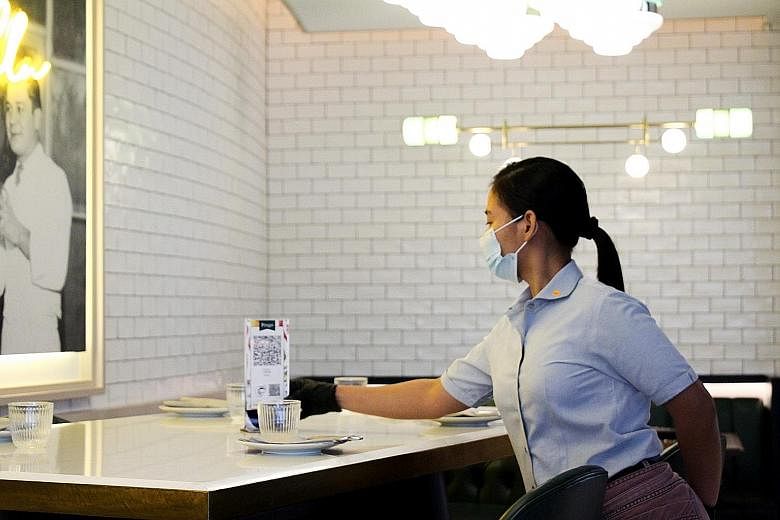It was not business as usual when restaurants reopened for dining in on June 19, during phase two of the economy's reopening.
To pre-empt a resurgence in Covid-19 infections, food and beverage establishments spaced out tables and blocked seats to meet social-distancing rules that require different groups of diners to be kept at least 1m apart.
Diners also had to check in and out via SafeEntry and have their temperatures taken.
Beyond these basic measures, many restaurants also replaced printed menus with digital ones that can be accessed by scanning a QR code on a smartphone.
Right now, most of these digital menus feature only basic text, without photographs of the dishes.
Many are also moving towards interactive iPad ordering, which eateries such as Swensen's have already adopted in a bid to be more efficient.
The chain of halal Western eateries launched it last year, and says it is in the midst of introducing dynamic QR codes as well.
Mr Teo Tong Loong, the group business development director of Swensen's parent company, ABR Holdings, says: "What began as initiatives to efficiently serve our customers before Covid-19 have now evolved to provide a safer dining environment."
He adds that the contactless menus will be a permanent feature at the 24 Swensen's restaurants islandwide. In the meantime, he notes that diners are "reassured when they see our staff disinfecting the iPads after use".
The ilLido Group, which runs five Italian restaurants, including Art and Amo, has not only adopted contactless menus, but its creative department is also working on how to replace primitive PDF pages with a more intuitive digital menu.
Says chef-owner Beppe de Vito: "In such circumstances, where human contact is limited, our digital menu aims to provide a personal touch and engage customers as closely as our staff would." For example, the new menu will feature more information on ingredients and personal stories behind the dishes.
Beyond minimising contact and creating a safer dining environment, going digital has the added benefit of reducing costs.
The Singapore Marriott Tang Plaza Hotel, which operates restaurants such as Wan Hao Chinese Restaurant and Crossroads Cafe, estimates that it spends about $5,000 a year on printing menus. It plans to launch digital menus this month.
Another hotel, Parkroyal on Beach Road, where Si Chuan Dou Hua restaurant is located, says it cut its printing expenses by 50 per cent this year by going digital. Putting its menu online also allows the Chinese restaurant to update its offerings easily.
The hotel's general manager, Mr Paolo Campillo, says it keeps some printed copies for guests who are not tech-savvy or do not have a smartphone. "For such cases, we ensure that the menu is sanitised with healthcare-grade disinfectant after each use," he adds.
But ilLido's Mr de Vito says that beyond printing costs, the true savings lie in the streamlining of time-and effort-consuming processes such as menu design and content updates. "Such intangible benefits are not easily quantifiable, but have a great impact on our operations," he adds.
Another area where restaurants are reaping efficiencies using technology is contactless payment.
Instead of waiting for your credit card to be processed at the counter, the server now comes to you with a portable terminal. You tap your card on it and the receipt is printed within seconds.
You no longer have to wait for the waiter to saunter to and fro with the bill and receipt. The time saved is used to serve other diners.
The Swissotel and Fairmont Singapore hotels have embraced technology extensively in their F&B outlets, such as Mikuni, Prego and Anti:dote. They will soon launch a system where diners can not only view the menu, but also order and pay the bill from their smartphones.
Their spokesman says: "Digitalisation was already being adopted into our business to enhance operations where feasible. What the Covid-19 pandemic has done is push digital revolution further to the forefront.
"This has been a great help to operations by enhancing the speed of service."
Private investor Chan Kwai Sum, 46, who dines out regularly, says that while he prefers flipping a physical menu, he is open to digital ones too.
He has visited restaurants such as Ishi, Salted & Hung, Braci, Ocean and La Strada over the past two weeks.
He observes: "Online menus should have good resolution and be sufficiently detailed."
He also suggests that they include links for everyone at the table - not just one representative - to make their orders online.
For him, contactless payment - either at the counter or via a portable terminal - is ideal, as there is no need for the server to handle his credit card.
Restaurants, too, say safety is the most important consideration for pandemic-era dining. Anything else is a fringe benefit.
As Swensen's Mr Teo notes: "Our priority is to provide an all-round delightful and safe dining experience for diners, something we cannot put a price on."


